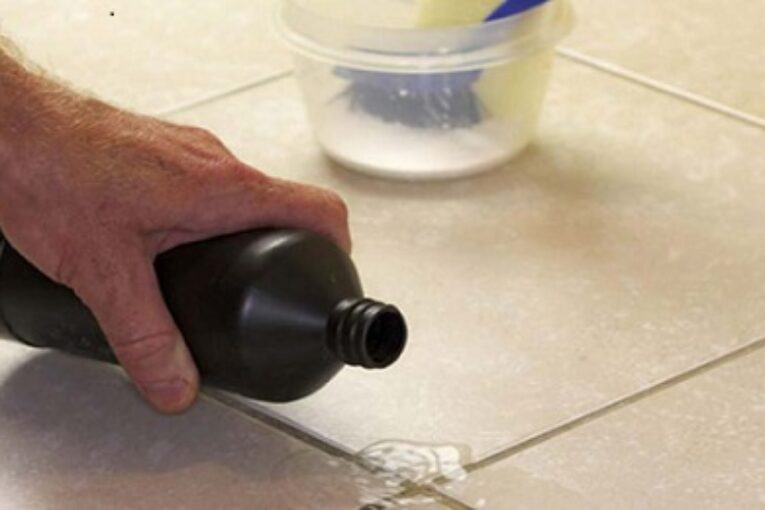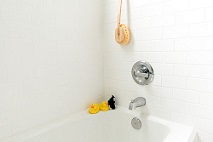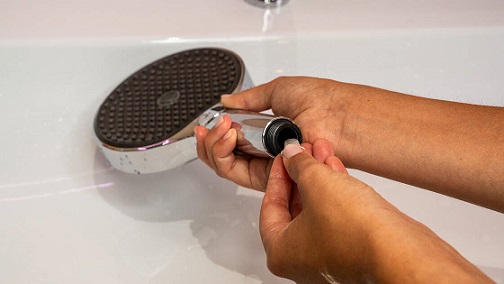
Between showers, baths, trips to use the toilet, and getting ready (and un-ready), bathrooms are a high-traffic area in every home—and staying on top of germs and bacteria calls for a regular cleaning routine with frequent disinfecting.
For a multi-use product that can tackle everything from toilets to towels, look no further than your cupboard. Cleaning the bathroom with hydrogen peroxide is both gentle and effective, and there are plenty of ways to use it within the space.
How Peroxide Cleans Your Bathroom
Hydrogen peroxide is a liquid containing hydrogen and oxygen molecules. It’s a gentle yet effective alternative to bleach; it works as an antibacterial, antimicrobial, and disinfectant—and even the readily-available 3% concentration can tackle germs and mold.1
Hydrogen peroxide cleans and tackles stains as it reacts and oxidizes, and breaks back down into water when exposed to sunlight which is why it is sold in dark bottles and should be used in a timely manner after opening.
In the bathroom, you can use hydrogen peroxide to clean:
- Showers and bathtubs
- Tile
- Toilets
- Glass surfaces like mirrors and shower doors
- Bathroom linens
- Beauty and hygiene tools
How to Use Hydrogen Peroxide to Clean the Bathroom
Showers and Bathtubs
- To clean a shower, fill up a dark spray bottle with hydrogen peroxide. Spray an even layer all over the walls and floor, let it sit for 15 minutes, then wipe away with a sponge.
- For a bathtub, spray with the same bottle and wipe away with a sponge after about 15 minutes. Stained bathtub surfaces can be treated by applying a paste made of 2 parts baking soda and 1 part hydrogen peroxide. After an hour, scrub the paste off with a sponge and rinse.
Tiles
- To clean wall tiles, spray the area down, let it sit for 15 minutes, and wipe away with a clean sponge.
- For floor tiles, pour equal parts hydrogen peroxide and water into a bucket. Use a microfiber mop, and allow it to air dry.
- For grout that needs a little extra help, create a paste using 1/4 cup hydrogen peroxide, 1/2 cup baking soda, and 1 tablespoon of dish soap. Leave the mixture on the grout for 10-15 minutes, then scrub away with an old toothbrush. Mop and dry the area.
Toilets
To disinfect a toilet with hydrogen peroxide, start by wiping down the seat and tank cover with dish soap or a multipurpose bathroom cleaner.
Next, pour 1/2 cup of hydrogen peroxide into the toilet bowl. Let it sit for 20-30 minutes, scrub with a toilet brush, and flush.
Glass Surfaces
For a streak-free clean on bathroom mirrors and shower doors, grab your dark spray bottle full of hydrogen peroxide and spray all over. Wipe down and dry with a microfiber cloth.
Bathroom Linens
Using hydrogen peroxide for laundry can help with stain treatment, brightening, deodorizing, and disinfecting, which is especially ideal for high-use items like towels, bath mats, and washcloths.
If you’re experiencing musty or mildewy smells, start by completely submerging items in a mixture of water and 1/2 cup of 3% hydrogen peroxide for 15-30 minutes.
Whether pre-treated or not, you can refresh bathroom linens by adding 1/2 to 1 cup of hydrogen peroxide to the washing machine alongside your regular detergent, then washing the towels like you normally would.
Beauty and Hygiene Supplies
- Metal tools such as eyelash curlers, tweezers, and nail cutters can be sanitized by submerging into hydrogen peroxide for 15-20 seconds, then wiping clean.
- Wipe down electric tools like hair straighteners, hair dryers, and electric toothbrushes with a cotton pad soaked in hydrogen peroxide.
- For makeup brushes, use a solution of 1 part water and 1 part hydrogen peroxide. Let the brushes soak for five minutes, then leave to dry.
Treat Stains
- You can treat stainson towels by applying hydrogen peroxide directly to the area and letting it work for 10 minutes, then washing as normal.
Warning
- Hydrogen peroxide becomes toxic when mixed with other substances, and should never be combined with bleach, ammonia, lemon juice, or vinegar.
Credit: Spruce





